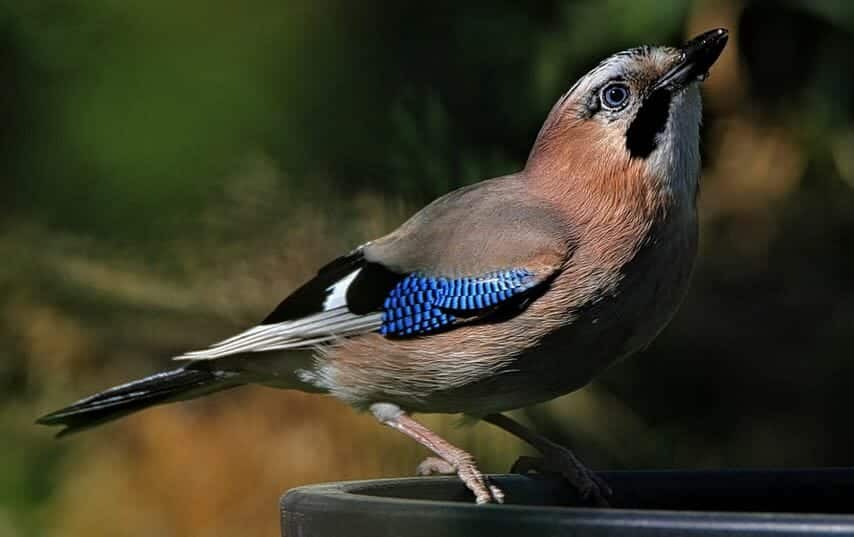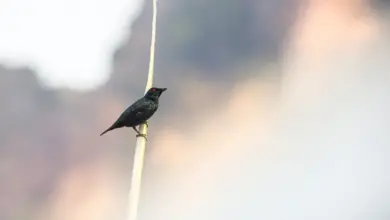Ruddy-capped Nightingale-Thrush, Catharus frantzii
The Ruddy-capped Nightingale-Thrush (Catharus frantzii) – also known as Frantzius’s Nightingale-Thrushes or Highland Nightingale-Thrushes – are sedentary (non-migratory) Thrushes found in the Middle American cloud forests.
They are the most widespread members of the bird genus Catharus (Nightingale Thrushes / Typical American Thrushes). The back is mostly brown; the crown is rufous and the underparts pale – which is a typical for this genus.
They are known for their rich song.
Distribution / Habitat
The Ruddy-capped Nightingales occur naturally in Mexico and northern Central America where they inhabit montane forests on both the Pacific and Caribbean slopes. They are most common at elevations ranging from 4,000 to 11,500 feet (~ 1300 to 3500 meters).
Even though they are highly sedentary, some may move to lower elevations during winter; and juveniles may move on in search of their own territories.
Mexico: On the interior and adjacent slopes from Jalisco, Michoacán, southeastern San Luis Potosí, and Hidalgo, south and east through Mexico
Guatemala: Central and southern parts
Honduras: Western and central areas
El Salvador: Mountains in western, northwestern and central parts
Nicaragua: North-central parts, including the national parks of Montecristo and Los Volcanes
Costa Rica: Mountains on both slopes, except avoiding the Guanacaste and Tilarán Cordilleras
Panama: Western Chiriquí highlands
Habitat: Wet to semi-humid coniferous, pine-oak and evergreen forests (cloud forests), dense broadleaf forest in deep canyons near bodies of water, and adjacent secondary growth.
Behavior: These shy birds are usually seen alone. When foraging on the ground, they hop as is typical of Thrushes.
Subspecies, Ranges and ID:
- Frantzius’ Nightingale Thrush or Ruddy-capped Nightingale-Thrush (nominate)(Catharus frantzii frantzii – Cabanis, 1861)
- Range: Northern Costa Rica
- ID: As described on this page
- Ruddy-capped Nightingale-Thrush (nelsoni) (Catharus frantzii nelsoni) Phillips, AR, 1969
- Range: Mountains of south-central Mexico – from southwestern Guerrero to southeastern Oaxaca
- ID: Like nominate form, except has a brownish wash to the chest
- Ruddy-capped Nightingale-Thrush (confusus) (Catharus frantzii nelsoni (confusus) – Phillips, AR, 1969)
- Range: Mountains of southeastern San Luis Potosí to central-western Veracruz and northern Oaxaca
- ID: Like ssp. nelsoni, but has duller, paler flanks, crissum (area between the vent and the base of the tail feathers) and rump
- Ruddy-capped Nightingale-Thrush (chiapensis) (Catharus frantzii chiapensis – Phillips, AR, 1969)
- Range: Mountains of southern Mexico east to western Guatemala)
- ID: Resembles ssp. omiltemensis from southwestern Mexico, but has slightly darker tail and uppertail feathers (coverts)
- Ruddy-capped Nightingale-Thrush (juancitonis) (Catharus frantzii juancitonis – Stone, 1931)
- Range: Northwestern El Salvador and Honduras
- ID: Like nominate form, except smaller size and a more reddish crown creating a more distinct contract between the crown and back
- Ruddy-capped Nightingale-Thrush (waldroni) (Catharus frantzii waldroni – Phillips, AR, 1969)
- Range: Mountains of northern Nicaragua
- ID: Resembles the ssp. juancitonis (from Honduras) – from with less brown wash to the chest and smaller size
- Ruddy-capped Nightingale-Thrush (wetmorei) (Catharus frantzii wetmorei – Phillips, AR, 1969)
- Range: Mountains of southern Costa Rica south to western Chiriquí in Panama
- ID: Like nominate, except paler crown, back and chest; less grey below
- Ruddy-capped Nightingale-Thrush (omiltemensis) (Catharus frantzii omiltemensis – Ridgway, 1905)
- Range: Southwestern Mexico – from Jalisco and central Michoacán to eastern Morelos; central-southern Guerrero and central-southern Oaxaca
- ID: Like nominate, except being duller above and whiter below
- Ruddy-capped Nightingale-Thrush (alticola) (Catharus frantzii alticola – Salvin and Godman, 1879)
- Range: Southern Mexico, from central and southeastern Chiapas to southern Guatemala and southwestern El Salvador, Honduras and northern Nicaragua)
- ID: Like nominate form, but greyer below
Description
Size
Small Thrush
Length: 6 – 7 inches (15 – 18 cm)
Weight: 0.10 – 1 oz (28 – 30 g)
Plumage Details / Adults
Upperparts range in color from brownish to olive, turning to a rich rufous-brown or deep ruddy-brown crown or “cap”, for which these birds were named. The face and the ear coverts (feathers covering the “ears”) are greyish, sometimes olive tinged.
The flight feathers are silvery-white on the undersides and rufous-brown above.
Below they are pale grey to whitish, with an olive tinge to the chest. The adult has olive-brown upperparts, a rufous crown and nape, pale grey underparts, turning whitish on the belly, and an orange lower mandible (bill).
Bare Parts
- Dark eyes (irises)
- Bill is blackish above, and orange-yellow below.
- Legs and feet are flesh-colored (pale to brownish)
Gender ID
Males and females look alike.
Juvenile Description
Darker faced. Upperparts, including head, are dull or dark olive-brown turning reddish-brown on the crown. Dark barring or spots on the abdomen. Slightly paler edges to the wings. The beak is tipped dusky below.
Similar Species
- Russet Nightingale-Thrush (C. occidentalis): The lower bill is dark tipped. The underparts are a paler grey.
- Orange-billed Nightingale-Thrush (C. aurantiirostris): Can be identified by the bright orange bill and eyerings, as well as their yellowish-orange legs and toes
Diet / Feeding
Their diet consists mostly of insects and spiders, but they will also take other invertebrates, small fruits and berries. They forage on the ground and in bushes, turning over ground litter in their search of prey. They have also been reported to follow ant swarms.
Breeding / Nesting
The breeding seasons vary by region; however, most nesting activities are observed between May through July; however, in some areas they may breed as early as February or as late as October.
The Ruddy-capped Nightingale-Thrush appear to be monogamous; even though they don’t form lifelong bonds, new pairings are believed to be established at the start of each breeding season.
Their bulky, cup-shaped nests are constructed out of twigs and lined with soft grasses and other fine plant material, hair and feather down. To the outside of the nest, they often attach moss – probably to help conceal the nest. The nest is placed about 3 – 14 feet (~ 1 – 4 meters) high in dense bushes, small understory trees or in bamboo, often near water.
The female lays and incubates two eggs that range in color from greyish, pale blue to greenish blue and are densely speckled and blotched with cinnamon-rufous and lilac spots and blotches.
The incubation time is 15 – 16 days. The nestlings remain in the nest for another 14 – 16 days. Both parents feed and protect the young.
These thrushes generally only breed once a year; but may attempt a second brood, if their first nest, eggs or young are destroyed.
Calls / Vocalizations / Sounds
Their beautiful songs are mostly heard in the mornings and evenings. It is described as far-carrying series of short, melodious whistles and warbles shee-vee-li-ee-ree; dleedle-edleeyee (Wetmore et al. 1984), shee-vee-li-ee-ree or shee-vee-shee-oo (Clement 2000) and their calls as high thin seet or whooeetor eeoolay, or a low and harsh kree-ee-eet (Wetmore et al. 1984).
https://www.xeno-canto.org/embed.php?XC=113085&simple=1
Alternate (Global) Names
Chinese: ???? … Czech: Drozd hn?dohlavý … Danish: Hætteskovdrossel … German: Bergmusendrossel … Spanish: Tordo de Capa Rojiza, Zorzal corona rojiza, Zorzal de Frantzius, Zorzal Gorrirojizo, Zorzalito de Frantzius … Finnish: Ruskolakkirastas … French: Grive à calotte rousse, Grive à capuchon marron, Grive à tête rousse, Grivette à calotte rousse … Italian: Tordo usignolo caporossiccio, Tordo usignolo di Frantzius … Japanese: chaboushichatsugumi, chaboushitsugumi … Dutch: Bergdwerglijster … Norwegian: Brunkroneskogtrost … Polish: drozdek rdzawoglowy, drozdek rdzawog?owy … Russian: ?????????????? ???????-????? … Slovak: drozd dubový … Swedish: Rosthättad skogstrast





